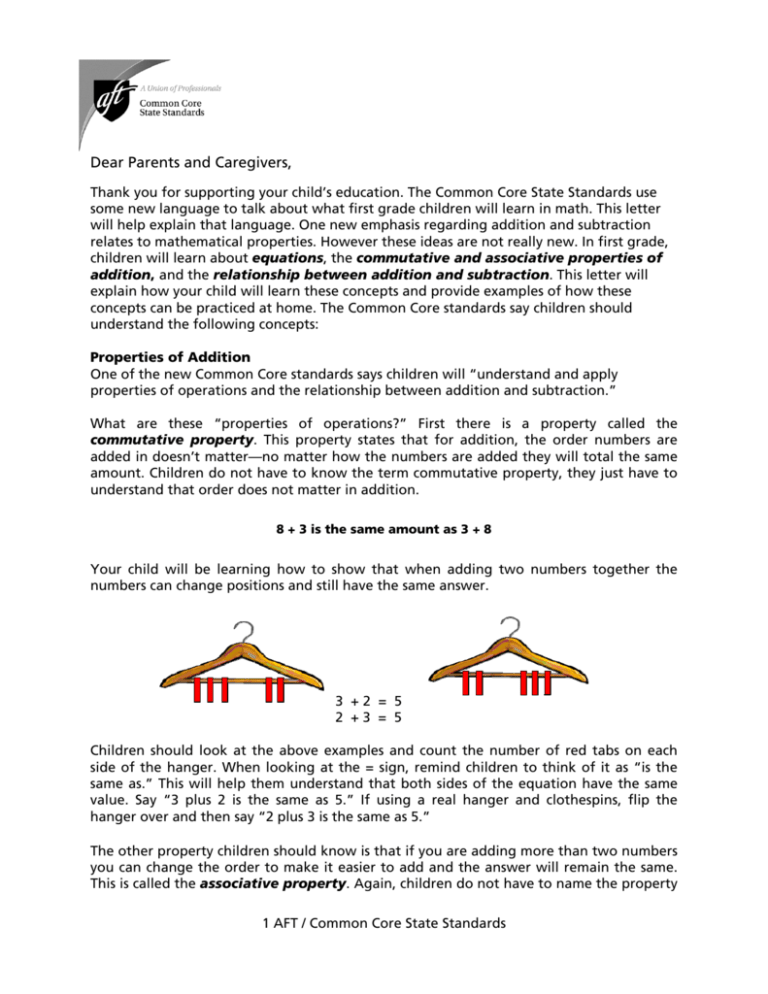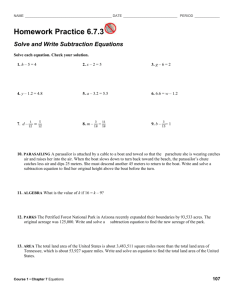Properties of Operations
advertisement

Dear Parents and Caregivers, Thank you for supporting your child’s education. The Common Core State Standards use some new language to talk about what first grade children will learn in math. This letter will help explain that language. One new emphasis regarding addition and subtraction relates to mathematical properties. However these ideas are not really new. In first grade, children will learn about equations, the commutative and associative properties of addition, and the relationship between addition and subtraction. This letter will explain how your child will learn these concepts and provide examples of how these concepts can be practiced at home. The Common Core standards say children should understand the following concepts: Properties of Addition One of the new Common Core standards says children will “understand and apply properties of operations and the relationship between addition and subtraction.” What are these “properties of operations?” First there is a property called the commutative property. This property states that for addition, the order numbers are added in doesn’t matter—no matter how the numbers are added they will total the same amount. Children do not have to know the term commutative property, they just have to understand that order does not matter in addition. 8 + 3 is the same amount as 3 + 8 Your child will be learning how to show that when adding two numbers together the numbers can change positions and still have the same answer. 3 +2 = 5 2 +3 = 5 Children should look at the above examples and count the number of red tabs on each side of the hanger. When looking at the = sign, remind children to think of it as “is the same as.” This will help them understand that both sides of the equation have the same value. Say “3 plus 2 is the same as 5.” If using a real hanger and clothespins, flip the hanger over and then say “2 plus 3 is the same as 5.” The other property children should know is that if you are adding more than two numbers you can change the order to make it easier to add and the answer will remain the same. This is called the associative property. Again, children do not have to name the property 1 AFT / Common Core State Standards but should know how this concept works in addition. For example, to add 2 + 6 + 4, the second and third numbers can be added first to make a 10, and then the child can add 10 + 2, which they know is 12. Usual way: 2+ 6 + 4 8 + 4 = 12 Making 10: 2 + 6 + 4 10 + 2 = 12 Relationship between Addition and Subtraction The Common Core standard also states that children should understand and use the relationship between addition and subtraction. This relationship is that addition undoes subtraction. For example, 14 – 8 = 6, but 8 and 6 can be added together again to end up with 14. Also, subtraction undoes addition. For example, 8 + 6 = 14, but taking away 8 from 14 is 6. What this means for children is if they have trouble with subtraction, they can use addition to help solve the problem. 11 – 5 = ? A child can think 5 + ? = 11 and get the correct answer: 6 Addition and Subtraction Equations and Strategies The standard also mentions different strategies children can use to add and subtract while they are learning. For 7 + 8, these include: counting on (children say “7” and then count 8, 9, 10, 11, 12, 13, 14, 15, keeping track of how many they have added on their fingers); making 10 (e.g., 8 + 6 = 8 + 2 + 4 = 10 + 4 = 14); decomposing a number leading to a 10 (e.g., 13 – 4 = 13 – 3 – 1 = 10 – 1 = 9); using the relationship between addition and subtraction (e.g., solve 12 – 8 by thinking 8 plus what number is 12); and creating equivalent but easier or known sums (e.g., adding 6 + 7 by thinking 6 + 6 + 1 = 12 + 1 = 13). The standards also ask first graders to work with addition and subtraction equations. This means they should understand that when an equal sign (=) appears in the middle of a number sentence, the amounts on both sides must be the same. Through the year, the equations will become more complicated. For example, you may see: 7 = 3 + 4 – The sum or difference sometimes comes first and one side has to be added or subtracted 5 + 2 = 2 + 5 – Both sides may have to be added or subtracted. 4 + 1 = 7 – 2 – One side may have to be added and the other subtracted. 6 + ? = 9 or 9 = 12 –? – A missing number may be in the middle, at the beginning or at the end. Where there are amounts to be added or subtracted on one side of the equation, children must do that addition or subtraction first to determine whether the amounts on each side are equal. If they look at 6 + ? = 9 and say the answer is 15, have them add 6 + 15 to see that 6 + 15 does not equal 9. 2 AFT / Common Core State Standards Number Lines Children will sometimes be given an equation and asked if the equation is true or false. They can use a number line, counters, or a 10 frame to model the numbers and prove whether the equation is true or false. Does 9 = 12 – 3? Students start at 12 and move 3 numbers to the left. They land on 9. That equation is true. Does 5 + 2 = 9 – 2? Start on 5 and move two numbers to the right to 7. Then start on 9 and move two spaces to the left to 7. That equation is true because the results on both sides are the same. 0 1 2 3 4 5 6 7 8 9 10 11 12 13 14 15 16 17 18 19 20 Counters Children can also use counters or drawings to add and subtract while they are learning one-digit sums and differences. For addition, they show each number and add all the counters. They can say, “four plus three is 7,” and write 4 + 3 = 7. For subtraction children can display the total (e.g., I had 9 stickers and used 3. How many are left? The total is nine.) and then take away the number being subtracted. 9–3=? 9–3=6 Other kinds of equations that can be used are: 7=8–1 5+2=2+5 4+1=5+2 6 + 3 = 18 – 9 Ten Frames Children can use 10 frames to model equations. Here is an example: We made 16 cupcakes and there are 7 left. How many did we eat? 3 AFT / Common Core State Standards First we show 16. Ten circles fill the frame and there are 6 more. Then we take away all but 7. Remove the “cupcakes” or cross them out on a drawing. 16 – 7 = 9 7 + ? = 16 On the right a child has started with the 7 that are left and then added the number needed to make 16. The relationship between addition and subtraction is used. Family Practice: You can show some counters on the 10 frame and ask how many are needed to make 15 or 14. (This practices equations like 8 + __ = 15.) Ask children to solve equations with missing parts. Show them a hanger with 4 clothespins on one side and the equation, and ask 4 + __ = 9. Ask them to tell you how many clothespins should be on the other side of the hanger. You can also use buttons, pebbles, Cheerios, or bingo chips to show numbers. This is also a time when children can practice a fact family. A fact family shows the relationship between addition and subtraction (4+5=9, 5+4=9, 9-5=4, 9-4=5). Make up stories about daily events and have your child solve the problems. For example, there will be six people eating supper. Here are two forks. How many more do we need? (2 + ? = 6) ________________________________________________ First Grade Teacher 4 AFT / Common Core State Standards






